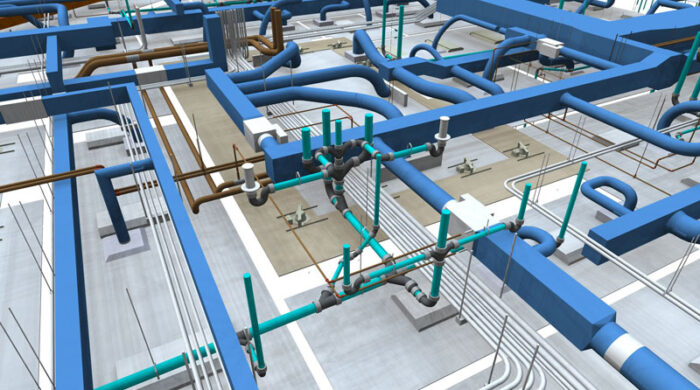When discussing a BIM project, one of the most common questions we hear is: ‘How much does BIM cost?’ The truth is that BIM pricing varies significantly based on project complexity, scope, and contractual terms. Whether you’re an A/E firm, contractor, or consultant, understanding the key factors influencing the cost of BIM in Construction can help you budget more effectively. This article will explore different approaches to estimating BIM costs in 2025 and provide strategies to optimize your BIM investment.
How is BIM Cost Determined?
As we may know, defining a price for BIM services is not like solving a simple equation where all members are known, as in 2+2=4. First of all, each project has its own scale and complexity. However, there is a wide variety of scopes and tasks that we, as consultants, can perform within the project and—luckily—be in charge of a whole one.
Within the design and construction phases, we can mention several scopes of work like BIM Modeling and trade coordination, Shop Drawings, Spooling, Scanning and Scan to BIM, Structural modeling and Detailing for Fabrication, BIM Management, As-Builts, among many others.
Common Methods for BIM Pricing Models
Although some organizations have their own metrics based on their expertise, no universal method exists to define or estimate all previous scopes. Nevertheless, there are ways to address this subject, at least to give a rough order of magnitude. For instance:
- Square footage metrics – Estimating cost based on the total building area.
- Percentage of construction costs – Applying a predefined percentage of the overall project budget.
- Linear feet of piping – Frequently used for MEP modeling, particularly piping and ductwork.
- Cost per deliverable – Pricing based on specific outputs, such as shop drawings, clash reports, or coordination models.
- Phase-based pricing – Dividing costs by project stages (e.g., conceptual design, detailed modeling, as-builts).
- Trade-specific pricing – Assigning costs per trade, such as mechanical, electrical, plumbing, or structural BIM services.
Since many BIM cost estimates occur during early project stages, it’s crucial to identify potential uncertainties and risks. When working with limited documentation, pricing becomes more speculative, requiring flexibility to adjust quotes once more details are available.
Key Factors That Impact BIM Cost: “It’s Not the Same”
That being said, it is important to discover, describe, and bring on the table as many attributes as possible to evaluate how they will impact our numbers and this is what we will call: It’s not the same.
1.Time Constraints
It’s not the same to deliver the first floor in one week as in three, like it’s not the same if we have to pay overtime to our team to deliver the model on time. Let’s be cautious and clarify these conditions with our clients and discuss how the schedule will impact the project cost.
2.Scope of Work
Some tasks can be estimated on an hourly basis. A good example would be 2D production, which we can approach by evaluating how long each sheet will take. In the same way, we can easily determine (as long as we have proper information) how much time the team will need to model one level of a cold-water piping layout.
3.Use of BIM and Level of Detail (LOD)
BIM’s purpose will drive us to define the LOD—the level of detail/development—that our model will require. It is very common for the Client to request this LOD, and sometimes, it must be part of our recommendations.
As we said, having a LOD 200 concrete model for rough quantification or one LOD 300 architectural model with different wall types, thicknesses, and materials is not the same. In the same way, it’s not the same a LOD 400 fabrication model, where we will specify how ducts should be cut for installation purposes. Let’s make sure the Client’s expectations are clear enough so we can suggest a reasonable LOD to make him save money and time.
4. Project Type and Complexity
It’s not the same to estimate the modeling efforts for an office building with large empty spaces as doing it for a healthcare project or an industrial facility. The type of project will help us understand the complexity of the model.
5. Type of Contract
It’s not the same to have a lump sum contract as a time and material. Who will absorb the rework cost in case revisions/redesigns come up? Who will absorb the price of a poor design? Many times, Lump Sum ends up being more expensive for the Client because, when estimating, the service provider has to estimate for potential issues that may never happen.
6. Availability of information.
As mentioned earlier, it’s not the same to quote one fully documented project, where we have every detail, rather than estimate one, where we have barely seen a floor plan or sketch. This point is about uncertainty since we won’t be able to come up with a tailored proposal. Our suggestion would be to provide ranges. We can polish our numbers afterward once the information is fully available.
7. Quality as a Non-Negotiable Factor
Consider Quality as a “non-negotiable” variable. A good quality model with consistent data will let our customers take the maximum advantage of BIM. At our end, it will help us deliver better results. Let’s not underestimate Quality; having some QA/QC % in our project’s budget is a must.
Get a Reliable, Instant BIM Cost Estimate with our Latest Tool
Numerous factors influence BIM pricing, from project scope and complexity to contract types and available documentation.
Each project requires a customized estimation approach to ensure all cost-impacting elements are accounted for.
Want a fast and accurate BIM cost estimate for your project? Try our new BIMEstimate tool, designed to help you calculate realistic budgets based on your project’s specific requirements.




